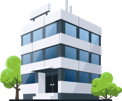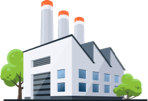What Are Uplink & Downlink Frequency?
In the world of telecommunications & networks, uplink & downlink essentially mean upload and download. Other terms such as upstream and downstream also apply.
For cellular devices such as smartphones & tablets, uplink and downlink pertain to the data speed and coverage we know as 4G/LTE, and newer radio frequencies such as 5G.
Signal coming to your phone from the cell tower is known as the downlink. Signal leaving your phone back to the cell tower is known as the uplink. In a perfect world, you'd get blazing fast internet speeds with everywhere-you-go coverage.
However, there are times when internal and external causes interfere with your service and speeds.
We fix poor cell phone signal! Find the right signal booster for you:




Causes of Disrupted Uploads & Downloads on Your Cell Phone
- Carrier Throttling. If you happen to go over your allotted data plan, even if it's "unlimited," carriers such as AT&T and T-Mobile can reduce your internet speeds.
- Cell Tower Distance. Long distance relationships don't work with cell phones and cell towers.
- Outside Interference. Tall trees, mountains, valleys, high structures, and other crowded development can easily alter and interrupted signals.
- Building Material. Virtually any building material can disrupt cellular signal and internet speeds. Cement. Metal. Sheet rock. Thick walls. Metal roof.
- Internal Interference. Surrounded by lots of electronics or other radio-frequency-disturbing devices? They affect cell signals.
- Mother Nature. Yes, even weather conditions such as thunderstorms, snow, and cloudy days interfere with uplinks & downlinks.
- Other People. Cell sites can technically serve hundreds to thousands of cell devices but not all at once. So those peak hours when you're making a call. You're going against other like-minded people.
How Uplink & Downlink Power in Cellular Signal is Measured
Cell phone signal strength is measured in decibels (dB) with reference to one milliwatt (dBm).
From a signal level of -50 dBm to -120 dBm, cellular signal can range from great signal (-50 dBm) to good signal (-80 dBm) to average signal (-90 dBm) to below average signal (-100 dBm) to near dead zone (-120 dBm).
This is the signal standard for all phones & cell devices, and for all carriers in North America.
In bar talk, -50 dBm represents full bars, while -120 dBm represents zero bars.
Most cell phone reception & service problems begin when signal strength ranges from -90 to -100 dBm. Within the range between -101 and -120 dBm, it’s possible to have working signal, but service is severely affected and spotty like a 101 Dalmatians.
For more info on how to measure your cell signal strength, click here.
It's important to know that decibels are measured exponentially. Even something as “small” as +3 dB represents 2x the power! Conversely, -3 dB means half the power.
This is the fragile nature of radio frequency, especially with cell phone signals. Check out the chart below to get a better understanding:
| Decibels | Amplified Power |
| +1 | 1.3x |
| +3 | 2.0x |
| +6 | 4.0x |
| +10 | 10.0x |
| +20 | 100.0x |
Everyone’s cell coverage is different thanks to factors such as carrier preference, cell tower distance, outside interference, building material, internal impediments, and user location.
Therefore, anything and everything can easily absorb, interfere, disrupt and block uploads & downloads from your cell phone.
How Commercial-Grade Pro Signal Boosters Improve Uplinks & Downlinks
FCC and IC approved commercial cell phone boosters are legally capped at +70 dB of max gain, which potentially adds a lot of coverage and signal strength.
Although pro-grade boosters are capable of boosting up to +70 dB, because of the factors listed above, real-world results generally range from a +3 dB to +42 dB gain for a majority of users.
That's a minimum of at least 2x amplified 5G/4G/LTE signal.
This boosted signal leads to more powerful uplinks and downlinks, which leads to the two most important benefits of owning a signal booster: faster internet data speeds & more coverage.
For example, let’s look at the two top-of-line WilsonPro cell signal boosters, the Wilson Pro 4000R and the Wilson Pro 70 Plus:
Wilson Pro 4000R uplink and downlink power output:

Wilson Pro 70 Plus uplink and downlink power output:

Both provide a maximum downlink signal boost up to 12.5x. However, the key difference is in the uplink power.
With an average difference of +3.24 dBm, the Wilson Pro 4000R is 2.11x more powerful than the Wilson Pro 70 Plus in the uplink power.
This translates to slightly more than 2x the coverage. The Wilson Pro 70 Plus provides coverage up to 50,000 sq ft. The Wilson Pro 4000R provides coverage up to 100,000+ sq ft.
Again, something as "small" as +3 dB or -3 dB can have discerning impact on coverage and performance.
For example #2, we'll look at our top two fleet & vehicle boosters, the weBoost Drive 4G-X and weBoost Drive 4G-M:
Drive 4G-X uplink and downlink power output:

Drive 4G-M uplink and downlink power output:

Both provide the same downlink output; however, the Drive 4G-X provides +3 dBm across all five bands on uplink power.
This leads to up to 2x the reach to the nearest cell tower while on the road or out in the field, especially in remote off-the-grid areas when signal and carrier service is limited.
For more about understanding how to boost uplink & downlink cellular speeds with signal boosters, we have some recommendations:
- Explain cell phone signal strength in terms of dBm.
- Talk about the 3 major components of a signal booster.
- And, of course, show the differences in models by uplink and downlink power output.
How May We Help You?
Wilson Amplifiers is the leading provider of cell phone signal boosters. Cell phone boosters amplify 4G/LTE and select 5G signals for any phone with any carrier for home, office, or vehicle.
We seriously hate dropped calls and poor coverage, so it's our goal in life to stomp on spotty signal like the little roaches they are:
- Free consultation (ask us anything) with our US-based customer support ( sales@wilsonamplifiers.com ) or call us at 1-800-568-2723 .
- Free shipping.
- Better signal or industry-leading 90 money-back guaranteed. No questions asked.
- We want everyone to be satisfied, so we provide lifetime technical support and a 2-year warranty for all products.
Ask us anything and we'll be glad to help.
Interested in Learning More? Check Out Our Signal Boosting Info Center


Money Back Guarantee

Technical Support